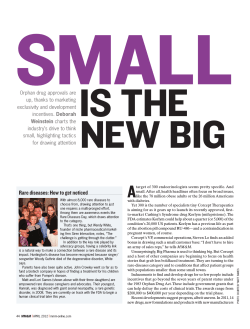
FDA Orphan Drug Designation 101 Gayatri R. Rao MD, JD Director
FDA Orphan Drug Designation 101 Gayatri R. Rao MD, JD Director Office of Orphan Products Development (OOPD) FDA October 12, 2012 1 Background 2 The Orphan Drug Act (ODA) • Decade prior to 1983 – only ~1 drug/year independently developed by pharmaceutical sponsors • Legislation needed to promote rare disease drug development • The Orphan Drug Act signed into law on Jan. 4, 1983 3 Orphan Drug Designation: Process Issues 4 Orphan Designation vs. NDA/BLA • Sponsors send request to the Office of Orphan Products Development (OOPD) to grant orphan designation to their drug or biological product to take advantage of financial incentives available for further product development • Sponsors then send NDA or BLA to the Center for Drug Evaluation and Research (CDER) or the Center for Biologics Evaluation and Research (CBER) to market their orphan drug or biological product 5 Office of the Commissioner (OC) OSMP OOPD Office of Special Medical Programs OMPT Office of Medical Products and Tobacco Office of Orphan Products Development Step 1: Orphan Designation CDER Center for Drug Evaluation and Research Step 2: NDA or BLA CBER Center for Biologics Evaluation and Research For Complete FDA Organizational Chart see: http://www.fda.gov/downloads/AboutFDA/CentersOffices /OrganizationCharts/UCM288864.pdf 6 Incentives Associated with Orphan Designation • When OOPD designates a drug or biological product as an orphan, certain financial incentives can flow: – Tax Credits – 50% of clinical trials costs – Waiver of User Fees - $1.9 M – 7-year Marketing Exclusivity 7 When to Submit an Orphan Designation Request Pre-Clinical Development Clinical Development CAN SUBMIT DESIGNATION REQUEST SUBMISSION OF NDA/BLA • No IND is required 8 After Designation Request Is Submitted… • Typical review cycle ~ 90 days (often less) • Will either receive: – Designation Letter OR – Deficiency Letter • Once designated, sponsor is required to submit annual reports until drug is approved 9 Orphan Drug Designation: Substantive Issues 10 Basic Definitions • What is an orphan drug? – Drug (or biological product) used for the prevention, diagnosis or treatment of a rare disease in the US; OR – Drug that will not be profitable within 7 years following approval by the FDA • What is a rare disease? – Disease/condition that affects <200K people in the US 11 Review of a Designation Request 1. What is the disease/condition? 2. Is the disease rare (prevalence) 3. Is there sufficient scientific rationale that demonstrates “promise” that the drug/biologic will treat, diagnose or prevent the disease/condition at issue? 12 #1 – What is the Disease or Condition? • Determine the disease/condition that would be treated, diagnosed or prevented by the drug/biologic • Challenging and can evolve Hodgkins’ Disease Lymphoma Non-Hodgkins’ Lymphoma Non-Hodgkins’ BCell Lymphoma Non-Hodgkins’ TCell Lymphoma Non-Hodgkins’ nullcell Lymphoma Follow the WHO classification so each subtype of each of these 3 categories is treated as a distinct disease/ condition 13 #2 – Is the Disease Rare? • Generally determined by prevalence of the disease in US, so prevalence must be less than 200K – Exception – For acute illnesses (duration < 1 year), use incidence EXAMPLE Malaria • For prevention claims, everyone who is at risk of the disease is counted EXAMPLE Prevention of ischemia reperfusion injury associated with solid organ transplantation 14 #2 – Is the Disease Rare? (cont.) • Sponsor must demonstrate prevalence – Must provide a specific number; not enough to say that the disease occurs in <200K persons • Sources to demonstrate prevalence: – – – – Published literature Registries SEER database for rare cancers 3 Independent expert opinions (last option) • If a range exists for the prevalence, apply the highest estimate EXAMPLE Myasthenia gravis Prevalence: ~ 43,500 – 63,500 15 #2 – Is the Disease Rare? (cont.) • If disease/condition is common (i.e., occurs in > 200K persons in the US), can grant orphan designation for use in a medically plausible subset (“orphan subset”) – Subset of all persons with the disease or condition who would only be expected to benefit from the drug Common disease Preeclampsia EXAMPLE Orphan subset Severe preeclampsia due to toxicity of product 16 Orphan Subset SCCHN • Prevalence of SCCHN in 2004 ~ 297,000 Ep-CAM Negative Ep-CAM Positive • Overexpression of Ep-CAM in 29% of SCCHN, ~86,000 • Proxinium™ targets Ep-CAM – Designated for Ep-CAM positive SCCHN Image: Stoecklein NH, Siegmund A, Scheunemann P, et al. Ep-CAM expression in squamous cell carcinoma of the esophagus: a potential therapeutic target and prognostic marker. BMC Cancer. 2006 Jun 23;6:165. 17 #3 – Is the Scientific Rationale Sufficient? • Basis of evidence that the drug holds promise for being effective in treating/preventing/diagnosing disease • Includes data from: – Clinical data, case study reports OR – Animal models OR – In vitro data (with proposed MOA and pathogenesis of disease when no adequate animal model) 18 Recent Publication by Lev et al., 2012Drug Discovery Today Scientific Rationale Presented by Sponsors for Orphan Product Designations in 2009 Scientific Rationale Number of designations (%) Clinical Experience Phase I 19 (17.92%) Phase II 47 (44.34%) Phase III 21 (19.81%) Phase of study not reported or specified 19 (17.60%) Total 106 (66.25%) Animal Study Primate 6 (12.24%) Large mammal 7 (14.29%) Rodent 38 (74.51%) Total 51 (31.88%) In-vitro Study Total Total designations 3 (1.88%) 160 Lev et al. 2012 Drug Discovery Today 19 Clinical Superiority • When seeking designation of a drug that is the “same” as an already approved drug, sponsor must provide a plausible hypothesis of clinical superiority • “Same drug” defined in regulation – Does not mean identical Small molecule with same active moiety as approved drug but different ester or salt EXAMPLES 2 proteins with minor differences in amino acid sequences 20 Clinical Superiority • Defined as: – Greater safety – Greater efficacy – Major Contribution to Patient Care – Rare Instances • Sponsor must demonstrate that the product is actually clinical superior at the NDA or BLA stage in order to get 7-years of marketing exclusivity 21 Designation vs. Labeled Indication • Often the approved labeled indication is narrower than the designation EXAMPLE Designation: Ofatumumab designated for the treatment of chronic lymphocytic leukemia (CLL) Approved Labeled Indication: Ofatumumab approved for the treatment of CLL refractory to alemtuzumab and fludarabine Approved Labeled Indication Indication covered by orphan exclusivity Designation 22 Valuable Resources Source Citation 1991 Proposed Rule 56 Fed. Reg. 3338 (Jan.29, 1991) 1992 Final Rule 57 Fed. Reg. 62076 (Dec. 29, 2992) 2011 Proposed Rule 76 Fed. Reg. 64868 (Oct. 19, 2011) 23 Orphan Designation Highlights: 1983-2011 350 350 300 300 Number of Orphan Designations Number of Designation Requests ~3740 Designation requests ~2600 Products have received Orphan Designation (~70%) 250 200 150 100 50 0 250 200 150 100 50 0 83 84 85 86 87 88 89 90 91 92 93 94 95 96 97 98 99 00 01 02 03 04 05 06 07 08 09 10 11 83 84 85 86 87 88 89 90 91 92 93 94 95 96 97 98 99 00 01 02 03 04 05 06 07 08 09 10 11 Year Year 24 Range of Designated Orphan Drugs* 2% 2% 2% Oncologic Metabolic 1% 2% 2% 2% 3% 4% 36% 4% Hematologic-immunologic Neurologic Infectious/parasitic Cardiovascular Transplantation Gastrointestinal Respiratory 4% 5% 6% 7% 7% 11% Endocrinologic Dermatologic Ophthalmic Musculoskeletal Injury/poisoning Perinatal Congenital abnormalities Others * Represents orphan drug designations through 2006 25 OOPD – What Else We Do 26 What Else Does OOPD Do? • Humanitarian Use Device (HUD) Designations • Orphan Products Grants Program • Pediatric Device Consortia Grants Program • Outreach – Science of Small Clinical Trials Workshop – Nov. 27-28, 2012 at FDA • Cross-agency coordination of rare disease efforts 27 Questions? For more information on OOPD’s programs, check out www.fda.gov/orphan Still have questions? • Email us at orphan@fda.hhs.gov OR • Call us at 301-796-8660 28
© Copyright 2025















